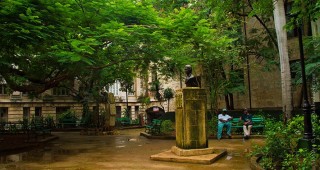Factoría Habana is an experimental center for present-day artistic creation. The institution, which is ascribed to the City Historian’s Office, seeks to become a bridge between Latin American and European art.
Factoría Habana is an experimental center for present-day artistic creation. The institution, which is ascribed to the City Historian’s Office, seeks to become a bridge between Latin American and European art.

 3
3Valued in approx 50 million dollars, the museum’s collections features medals, coins and banknotes from around the world, including an early 20 peso coin, the only one still existing of the ten produc …
 ModernAdmission: CUC 1Open: 9am-5pm Tues-SunObispo at 305, e/ Aguiar y Habana, Habana Vieja
ModernAdmission: CUC 1Open: 9am-5pm Tues-SunObispo at 305, e/ Aguiar y Habana, Habana Vieja 
 3
3In this 19th-century house, the scientist Alejandro de Humboldt installed his instruments and botany and mineral collections while ensconced here 1800-1801. Restored as a museum in 1997, the five exhi …

 3
3This 1920s eclectic hotel is best known for being described by Hemingway as “a good place to write.” He stayed here during the 1930s and this is where he wrote his chronicles on fishing and the first …
 EclecticAdmission: FreeObispo #153, esq. a Mercaderes, Habana Vieja
EclecticAdmission: FreeObispo #153, esq. a Mercaderes, Habana Vieja 
 3
3Although modified by later reconstructions, this Art Nouveau apartment building has preserved its beautiful wooden door carved with floral motifs and flanked on both sides by two slender stone pelican …

 3
3The construction of the Alameda de Paula, one of Havana’s first promenades, was commissioned by Captain General Felipe de Fondesviela, member of the court of King Carlos III, and built by architect An …

 3
3Built in 1915, it was reconstructed and remodeled in 1938 according to a project which was awarded the Gold Medal by the National Architects’ Association. Its pure Art Deco façade is faced with a mixt …
 Art DecoAdmission: NonePaseo de Martí (Prado) esquina a Colón
Art DecoAdmission: NonePaseo de Martí (Prado) esquina a Colón 
 3
3The Hermanos Ameijeiras hospital opened on December 3, 1982. In the late 1950s the dictator Batista planned the construction of a new building for the National Bank of Cuba on the grounds where the Ho …
 Modern
Modern 
 3
3Built in 1912, the building was conceived as a grand palace. Lavishly ornamented on its facade, it features overhanging balconies and windows which break the horizontal line of the balustrade. This mo …
 EclecticAdmission: FreeCárcel #51 esq. a Zulueta, Habana Vieja
EclecticAdmission: FreeCárcel #51 esq. a Zulueta, Habana Vieja 
 3
3In 1953, architect Antonio Quintana won the competition for the design of a building which would house doctors’ offices, stores and other public spaces. The use of brise-soleil, popularized by the Fre …
 ModernL entre 23 y 21
ModernL entre 23 y 21 
 3
3Stretching 14 blocks, this street takes its name from the San Lázaro Hospital built in 1746. It was s=successively renamed as Calle Ancha del Norte, Calle del Basurero, Avenida Antonio Maceo and Aveni …